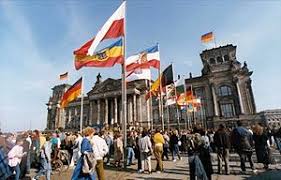In 1990, the reunification of Germany marked a historic moment in European and world history, bringing an end to decades of division and Cold War tensions that had separated East and West Germany since the end of World War II. The reunification of Germany in 1990 was the culmination of a long and complex process that had begun with the fall of the Berlin Wall in 1989 and the wave of political changes that swept across Eastern Europe in the late 1980s. The reunification of Germany in 1990 was a momentous event that symbolized the end of the Cold War and the reunification of a nation that had been divided for over four decades. The division of Germany after World War II had been a result of the Allied powers' decision to partition the country into two separate states – the Federal Republic of Germany (West Germany) and the German Democratic Republic (East Germany) – with distinct political, economic, and social systems. The construction of the Berlin Wall in 1961 further solidified the division between East and West Germany, creating a physical and ideological barrier that separated families, communities, and the nation as a whole. The reunification process began in earnest in 1989 with the peaceful revolutions that swept across Eastern Europe, leading to the fall of communist regimes in countries like Poland, Hungary, and Czechoslovakia. In East Germany, mass protests, demonstrations, and calls for political reform culminated in the opening of the Berlin Wall on November 9, 1989, a momentous event that signaled the beginning of the end of the division between East and West Germany. The reunification of Germany in 1990 was made possible through a series of negotiations, agreements, and diplomatic efforts between the governments of East and West Germany, as well as the support and involvement of key international actors, including the United States, the Soviet Union, and other European countries. The reunification process was guided by a commitment to democracy, human rights, and the principles of self-determination and national sovereignty, as well as a desire to heal the wounds of the past and build a more unified and prosperous future for the German people. On October 3, 1990, the reunification of Germany was officially declared, as the German Democratic Republic (East Germany) acceded to the Federal Republic of Germany (West Germany) to form a single, unified nation. The reunification process was met with celebrations, joy, and a sense of hope and optimism for the future, as Germans from both East and West came together to mark this historic moment and to envision a new era of unity, peace, and progress. The reunification of Germany in 1990 had profound implications for Germany, Europe, and the world. The reunified Germany emerged as a powerful and influential player on the global stage, playing a key role in the European Union, NATO, and other international organizations. The reunification process also led to significant economic, social, and cultural changes within Germany, as East and West grappled with the challenges and opportunities of integration and reconciliation.
1990 U.S.A. Reunified Germany
